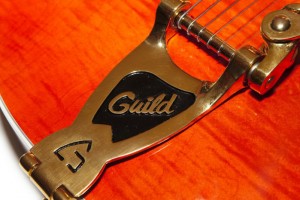
Back in the halcyon days of the very early 80’s, I took my 17-year-old self into a local music store and bought the guitar that I had been lusting after for a year. It was a Guild S300A-D, and it was the coolest looking guitar I’d ever seen. Had I enjoyed the gift of prescience, I would have probably bought the old Gibson 1959 Les Paul in the store across town, but that was just dumb old guitar – this thing was the future! Fast forward 30 years and the Guild S300A-D is worth what I paid for it – about $1000. Not bad. That Gibson though, in good condition might fetch a cool quarter of a million dollars. Ah the decisions of our youth.
That Guild electric was my sole guitar for 30 years. and it would shape my guitar buying decisions later in life. Why? Because it was a magnificent instrument. Over the years I played in bands covering classic rock, hair metal, rockabilly and even jazz (though admittedly not very well). The Guild could keep up with it all. In the 30 years that I owned it, I never once had to use the truss rod to adjust the neck. The only problem I ever had with it had to do with the Dimarzio pickups. They started squealing in the late 80s, but only at loud volume, which as my aging hearing will attest, was all the damn time.
After the turn of the century (God I feel old saying that), children came into our lives and my guitar habit waned. The Guild sat in the closet for years until I got on a “get rid of stuff I don’t use binge” wherein I sold my beloved Guild to someone who offered me $1000 for it. For about a year I was OK with the decision until I got the bug to start playing again, and my mistake started to weigh heavily on me. I offered to buy my guitar back, but the new owner wasn’t willing to sell. I went on a hunt to find a replacement and found one in even better condition on eBay. It wasn’t *my* guitar, but it was as close as I would ever come.
Anyone who plays guitar will likely tell you that they suffer from a condition colloquially known as GAS, or Gear Acquisition Syndrome. I too suffer, or rather my wallet does, from this affliction. While GAS is a troublesome disease, it is made worse when a certain brand of guitar if favored. In my case, loving Guild guitars was a problem, one that could only be solved by owning more Guild guitars. The cycle had begun.
Just before I bought my Guild S300A-D back in 1980, a good friend of mine had bought a Guild Starfire IV. It was a beautiful instrument that matched my Guild with its beautiful blond finish. I decided that I wanted one. I scoured the Internet until I found the perfect guitar – a 1999 Guild Starfire 4.
If you’re wondering why I can’t seem to decide between Starfire IV and Starfire 4, there’s a perfectly valid reason. The vintage Starfires used the roman numeral numbering, while the modern reissue Starfires use regular Arabic numerals. If a Starfire is from the 1970s, for example, then it’s a Starfire IV. If it’s from the 1990s or early 2000s, then it’s a Starfire 4. To keep matters simple, from here on out I will refer to all Starfires with roman numerals.
That Starfire was a magnificent instrument, but it didn’t nail that vintage Guild sound that I remembered from my friends guitar. I attributed this not only the age of the wood, but the pickups in the guitar. They looked like the same pickups, but as I would come to learn, they were cheap imitations.
In my quest for that vintage Guild sound, I found an almost mint 1973 version with vintage Guild HB1 humbuckers, a master volume, harp taipiece and beautiful block inlays. That guitar had the sound I was looking for, but those old Guilds have really skinny necks, and I have really big hands, so it just wasn’t meant to be. I then bought another vintage Guild, this time from 1976, and made of mahogany. The guitar sounded even better than the ’73, and the neck was a little deeper, but it was still to small for my hands. I sold off the vintage Guilds and kept the 1999 version because the neck was just perfect for me.
On these late-year Guilds, Fender (who still owns Guild) replaced the pickups with a Fender-made version of the HB1. Honestly it’s not a very good pickup, so I had them rewound by a boutique pickup winder and now the guitar sounds pretty darn sweet. With the right pickups, these guitars are, in my opinion, better and more consistent than 95% of the ES-335s out there.
Somewhere in life I fell in love with the music of Brian Setzer. Of course listening to the Stray Cats and the Brian Setzer Orchestra made me lust for an Orange Gretsch, and that’s when I found a relatively rare gem in the Guild lineup: The Guild X170T. The Guild X170T is an X170 jazz guitar outfitted with a Guild-labeled Bigsby tremolo (nicknamed the Guildsby by Guild aficionados), a coil tap switch that splits both humbuckers, gold trim, and a hot Tennessee Orange finish. I knew the minute I saw it that I had to have one.
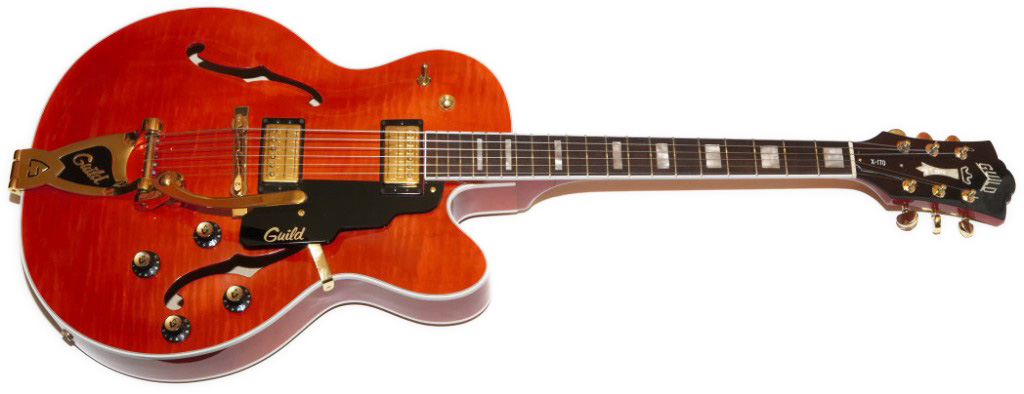
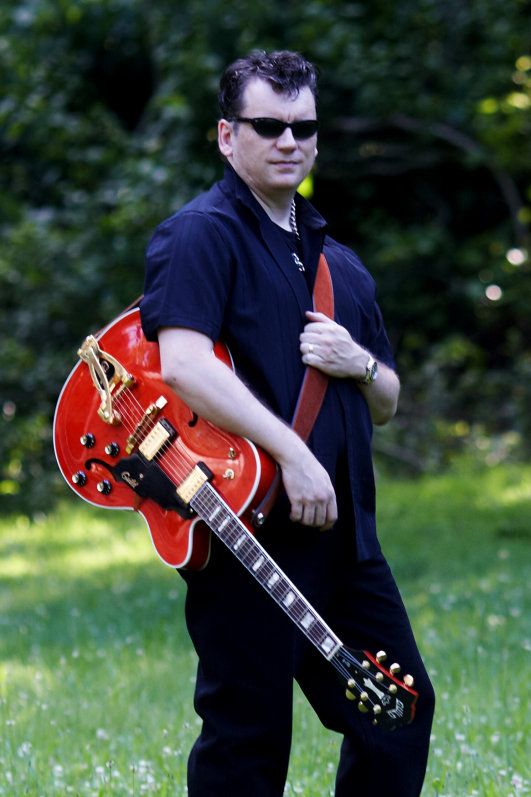
After the joy of owning a Guildsby-equipped X170T, I found that my Starfire 4 was getting lonely. When I played it, I adored the sound, but the lack of a Guildsby made it less fun for the music I was playing. For 30 years I had never had a guitar with a tremolo bar, and now I was missing it. Oh, and for the record, I know it’s really a vibrato, but Leo Fender called it a Tremolo in the 1950s and we’ve all blindly repeated the mistake ever since. Regardless of what the whammy bar is technically called, there was only one thing to for me to do in order to get one on a Starfire — find a Starfire III.
The Starfire III is similar to the X170T, but it’s the same thickness as the Starfire IV. Where the Starfire IV has a center block like a Gibson ES-335, the Starfire III is a full hollowbody like the X170T. Actually the X170T has a sound post in it to reduce feedback while the Starfire III is a completely hollow guitar. To summarize the often confusing nomenclature of the Starfire line:
Starfire I: Very early 1960’s Stafires that came with only a neck pickup.
Starfire II: Thin completely hollow body guitar – harp tailpiece
Starfire III: Same as SFII, but with a Guildsby vibrato tailpiece
Starfire IV: Thin semi-hollow body guitar – large center block – harp or stop tailpiece
Starfire V: Same as SFIV, but with a Guildsby vibrato tailpiece
Starfire VI: Same as SFV, but with high-end appointments. Highly flamed wood, gold hardware, 7-layer binding, bound ebony fretboard, abalone inlays, etc.
Back on Ebay I found a local musician who was selling a mahogany Starfire III from 1997 in mint condition. I made a trade, jumped on the chance and scored another Guild Electric Guitar.
I love mahogany electric guitars, and this one was no slouch. I discovered that this one had a little something extra to the sound though compared with my 1999 SFIV and X170T. Around the time this guitar was made, Fender hadn’t yet mucked with the HB1 design, and instead had put Semour Duncan pickups called SD1s into old HB1 covers. These SD1 pickups are much better than the later Fender psuedo-HB1s. If you’re hunting for a Guild from the late 90s, you would do well to try and get one with the SD1 pickups because they sound significantly better than the Fender HB1s found in the late 1990s and early 2000s models.
One of the things you immediately notice when you pick up a Starfire II or Starfire III is the weight. They’ve very light, especially if you’re used to a nine-pound guitar like a Les Paul. Without the center block of the Starfire IV or the additional thickness of the X170, the Starfire III is a featherweight. This guitar will play every ounce of smokey blues tone you can pull from it, will play great jazz clean tones, and will rock loud and proud with the best of them. The only downside of this guitar is that the fully hollow body will feed back at the slightest provocation. If you’re clever you can turn that tendency into some great feedback/sustain tricks, but if that is a skill you can’t seem to master, this guitar might be frustrating at loud volumes. Just keep your hands on the strings when you’re not playing, or better yet roll the volume off, and you’ll minimize the problem. The trouble of dealing with feedback is well worth it given the fun and variety of sounds you can get from this guitar.
In addition to the pickup difference I’ve mentioned, there are some differences between the vintage guild electric guitars and the modern “reissue” Guild electrics that are worth noting. The reissues are from the mid to late 1990s. The vintage Guilds I’ve seen range from the 1950s to the 1980s. Speaking mostly about the Starfires, the biggest differences in my experience are:
Pickups
- Vintage Guilds have true HB1s that are amazing in every way. Think Gibson PAF but more consistent. Some older Guilds even have mini-HB1s, which are supposed to be wonderful, though I’ve never had the pleasure of trying them.
- Mid-late 90s Guild electrics have Seymore Duncan SD1 pickups that are great, but not as good as vintage HB1s. I have no idea what the actual date range where these pickups occur. All I know is that my 1997 SFIII has SD1s and my 1999 SFIV does not.
- Late-1990s and early 2000s Guild electrics have Fender psuedo-HB1s that I personally find boring.
Finish
- Vintage Guild electrics generally have a lacquer finish that I prefer. Both of my 1970s Starfires were finished with lacquer. I do not know about the 80’s models.
Modern Guild electrics generally have a polymer finish that doesn’t bother me at all (though it’s not as sexy feeling as lacquer). My 1997, 1999, and 2000 Guild electrics are all Poly finished. See the comments below where a Guild employee set me straight that my late-model Westerly Guilds are, in fact, lacquer coated.
Necks
- Every 1970s vintage Guild Electric that I’ve owned has a 1 5/8 inch neck (measured at the nut). Some have a deeper cross-section than others, but they’re all pretty skinny to my hands.
- Every modern reissue Guild electric I’ve owned had a nice wide 1 11/16 inch neck. I greatly prefer the necks on the reissues since I have large hands.
Bodies
- My 1970s Starfires had thicker bodies than my 1990s and 2000 Starfires. The picture to the right shows a late 1999 Starfire on the left and a 1973 Starfire on the right.
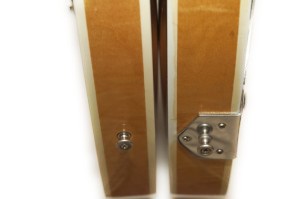
Tailpieces
- All the vintage Starfire IVs I’ve owned or played had harp tailpieces. You can see this on the blond 1973 Starfire above. You can also see that the 1999 Starfire shown above has a stop bar tailpiece. Again I do not know the cutoff years for this change.
Many of the other Guild electrics changed over the years. I couldn’t begin to list or know them all, and would instead refer you to Hans Moust, author of The Guild Guitar Book. See the last paragraph for more information. He’s a busy guy though, so please be conscious of that fact if you decide to contact him.
Over the years I have owned nine different Guild electric guitars. Every one has been a fantastic guitar. Even better, none of them cost me more than $1,200 – even the vintage ones! That’s right, you can get a vintage Guild Starfire IV that rivals a vintage ES-335 in tone for only a little over $1000. I’ve even seen them go for $800 on eBay. Try to find a vintage ES-335 for that price. I bet the vintage Guild is a nicer guitar anyway.
I am no expert, I’m just a happy Guild electric guitar owner who’s been obsessing about them for 30 years or more. There are many Guild electric guitars that I have not owned, including the M-80, the S280, the S-100, and the coveted S-200 to name a few. What I do know though, is that based on my experience with every Guild electric I’ve ever owned or played, I would not hesitate to own any Guild electric guitar. I have never seen a bad example of a Guild electric guitar. Even after Fender had their way with them, Guild still put out amazingly consistent high-quality electric guitars. I personally feel it is a sin that Fender discontinued Guild’s electric guitars. I hope that they reintroduce these great guitars some day soon.
All of this information is based on my observations from the guitars that I’ve owned. I’ve also learned a great deal from the folks on the LetsTalkGuild.com forums, and I would be remiss if I didn’t tell you to go find a copy of Hans Moust’s excellent book The Guild Guitar Book. Word is that Hans is working on a new book that covers the modern era of Guild guitars including the ones I’ve written about above. I for one, can’t wait to get my hands on a copy! In the meantime I’ll be scouring the Internet for used Guild electrics.
If you liked this article, please visit GADsGuilds.com for far more detailed articles about various Guild guitars, amps, and everything else Guild.
Donate: PayPal Crypto:
ETH: 0x0AC57f8e0A49dc06Ed4f7926d169342ec4FCd461
Doge: DFWpLqMr6QF67t4wRzvTtNd8UDwjGTQBGs

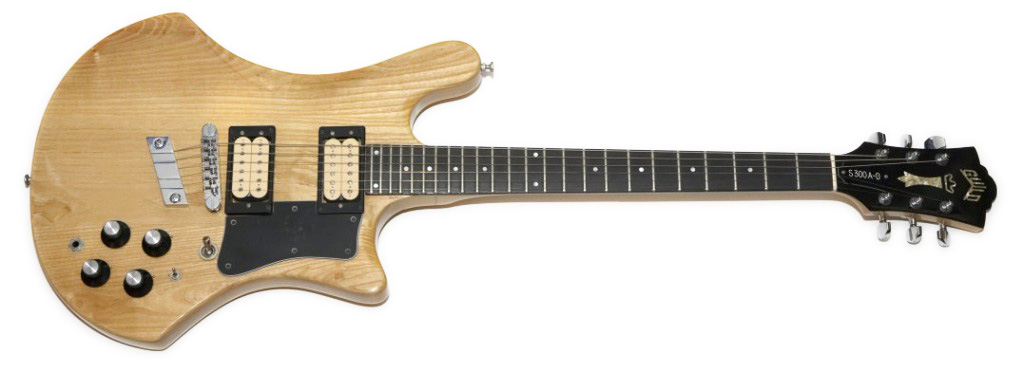
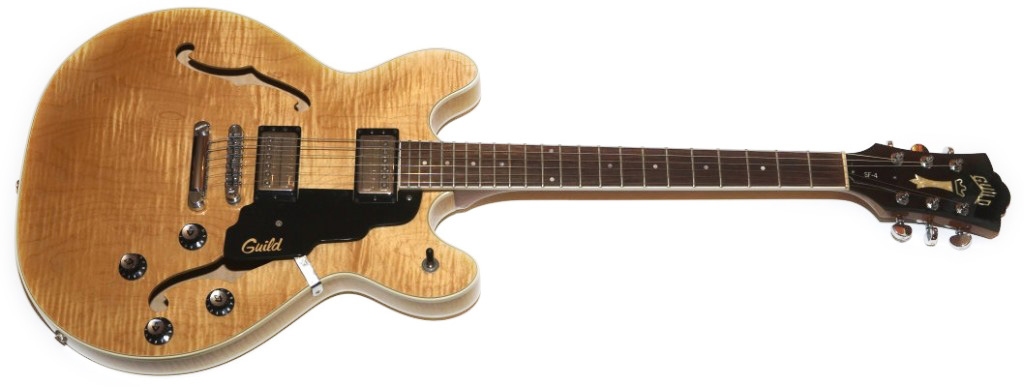
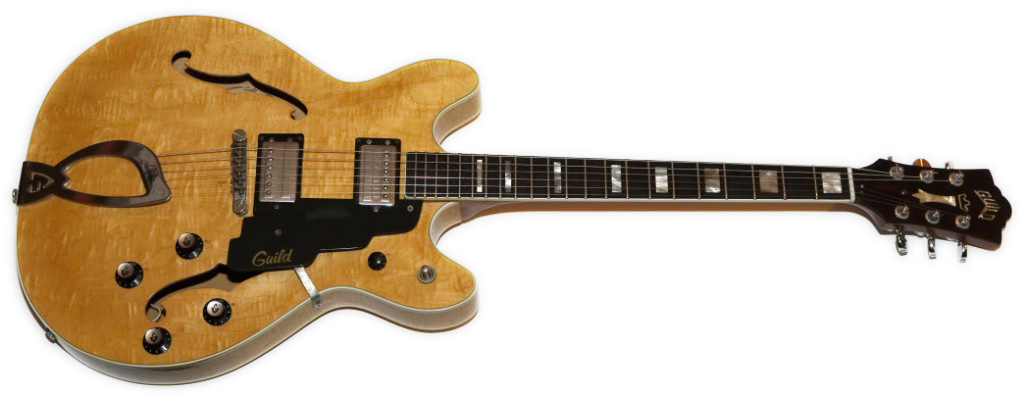
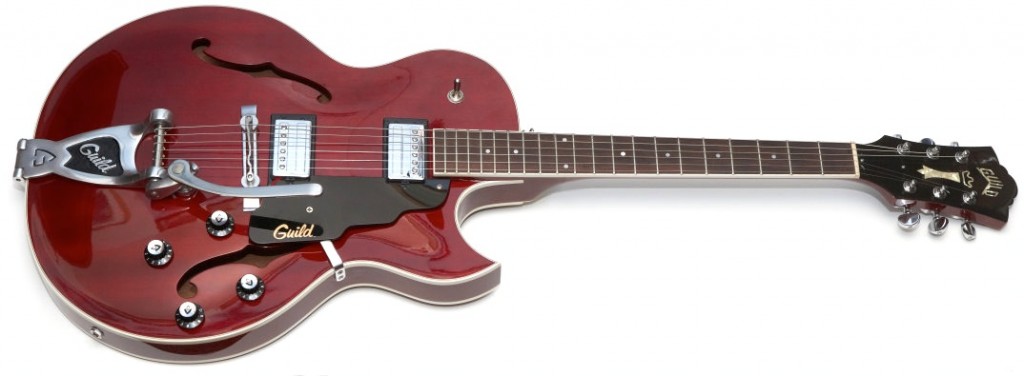
Nice pics and bloggering.
I enjoyed this article (and the dog articles too), also the Jackson article.
I’ve played guitar a long time and had the usual GAS, but I must admit the modern Guilds (as opposed to real vintage models) trip my trigger more than in years past. I have followed the Guild line since I started playing in 1960, and have owned flat-tops and archtops, as well as a Starfire “4” 😉
I REALLY like X-series archtops (like that orange X-170T in the article), and my ’06 X-150 seems to me to be one of the most excellent guitars of any type I’ve personally owned, though I’ve had spendier.
Hi,
I’ve owned and parted with a lot of Guilds over the years, acoustic, electric and acoustic/electric…
My 1st Starfire experience was a college friend’s red mahogany early 70’s SFIV. It was totally not of the style of music I was into but I must have recognized the quality of it because it seemed like a beautiful thing – I was very much a rank beginner so it never occurred to me that I would own one someday.
I’ll spare you the winding road story from then till now, but I’ve owned 3 SFIV’s (and a II and a III) along the way, plus a Dearmond Starfire just for good measure. When I was in my 20’s, I liked everything about the IV but the harp tailpiece because I thought it didn’t look cool. Now that I’m in my mid 50’s and can’t seem to find any affordable 70’s era IV’s, I prefer the harp over the stop-bar versions.
I parted with all of my Guilds at one time or another in the pursuit of the ultimate guitar (and near financial ruin!) and find myself at a point where I’ve got a reasonable amount of guitars (under 10, down from a high of 50+!!!) and am once again feeling the urge to own a SFIV – but only from the era where it had the harp tail, master volume, and block inlaid fretboard. E-bay seems rife with pre- and post-70’s era models, but very few from the 70’s in the aforementioned configuration,
although as I type this there’s a ’74 Blonde IV on the ‘bay, but it’s a stereo model (cool) that has an asking price of $2100+ (not cool). As a Guild owner, I would have been elated to see that type of price escalation, but as a potential buyer, not so much ‘-)
Anyway, my real point is that it was great reading your thoughts on the Starfires and Guild Electrics and thank you for filling in a few blanks in my Guild trivia memory-bank.
See you down the road.
Ed Gallagher
I am also a Guild Archtop Fancier. A Starfire l was the same as a
Starfire ll but with a single pickup in the neck position.
Bob Shaw
Starfire custom 3 pickups. Has anyone seen one.
Larry:
Check Has Moust’s book. There was a Starfire 7, which I believe was a variation on the X-350/375 with three pickups.
Great article. I just won an Ebay auction for a 79 Guild, and can’t wait to give it a new home. Thanks for the read.
Hi Gary:
Nice site and very informative. It’s pleasure to meet another Guild aficionado. My first Guild was a cherry SF V, about 1970 or so. It was a beautiful guitar, a gift from my Mom and Dad. I did not appreciate how sweet until years later. Unfortunately, it was stolen in a home burglary in 1975 and replaced by an also very sweet SF IV. I still have fantasies that my original will show up some day. You never know.
Enjoy!
John
Very nice article. I too have the Guild Bug. I bought my first one back in 1996 when I learned that Fender bought them. I found a September 1995 Westerly, RI made D4 to replace my aunts old Hondo II. Next, I bought a 1979 100% Mahogany B-301 Bass which is mint and the bass that I record with. Last month I came across a 1997 X-170 Manhatten with gold hardware including the Guildsby and original case. Not sure which pickups I have in it but to me it sounds great and I had to have it. So I own 3 now much to the dismay of the wife but I can’t help the love I have for these wonderful instruments. Thanks again for the write up.
Gary,
I worked in the repair department at the Westerly Guild factory from ’99 – late ’00. We did a lot of spraying and drop fills on customer owned and production pieces. It was all nitro. If you have Westerly built “…1997, 1999, and 2000 Guild electrics…”, those aren’t poly my friend.
Jay, do you remember on the 98-2000 Westerly X150’s with Sunburst what stain they added to the lacquer for the dark red-brown color at the periphery of the burst and the peg head? Thanks
Great article, loved your story about how you’ve rediscovered your love of guitars and playing. I understand fully how life sometimes gets in the way so I’m also getting re-acquainted with my love for guitars and playing. I have a new Starfire VI on order, I’ll let you know how it goes, but I think from your writing, you already know………all the best.
I just purchased a 1999 orange X170T like yours except the toggle switches are not together on one side of the upper bout. Do you know the “official” name Guild gives this color? “Tennessee Orange” like Gretsch? “Transparent Orange” (suffix “TPO”)? I like your reference to “Hot Tennessee Orange”!
Val
The toggle switch position changed. The switches together like the one in my pics was only on the very early models. Later models have them on separate bouts which is a much better layout IMO. So far as I’m aware, the color is Tennessee Orange, though if it’s not it’s likely something like Transparent Orange.
Good information. I have also heard this color referred to as “burnt orange”, but Guild must have nicked the “Tennessee orange” name from Gretsch.
Hi. What about the Starfire XII. Any comments, info or experiences?
Unfortunately, I have never played one, but I know people who have and like them.
What an interesting and informative site! I’ve only owned one Guild electric guitar, a 1966 Starfire lll. It’s a beautiful, soulful guitar that, despite its thin neck and frets, sounds distinctly different from all my other instruments. Played through an older Fender tube amp it gives me the sound I like the best. It’s been fun Looking over your site, but now I want another Guild or two, maybe three.
Thank you for the fascinating info on Guild electrics. Would you know what the differences are between the Guild Duane Eddy (DE-500) and the Starfire III?
Best Regards,
John W
The DEs (There is a DE400 and a DE500) are much higher-end signature guitars that are much more rare than the Starfire III. The DEs were made for a short time in the ’60s and were reissued for a very short time in the ’80s (there are very few of these) and the DEs are VERY expensive.